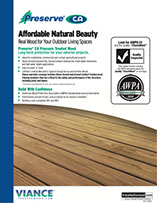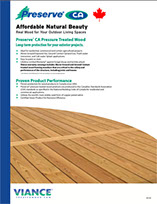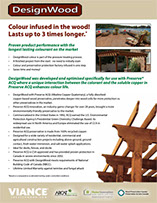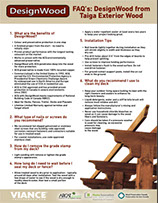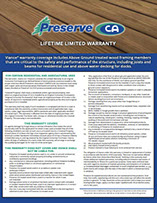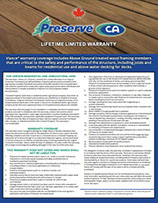
RESOURCES
DesignWood®, color-infused treated wood – a finished project from the start!
DesignWood Product Information Video
Preserve CA-C Product Information Video
Preserve CA-B Product Information Video
Preserve CA Green Certified Product Certificate
Click a thumbnail to view or download the Preserve Green Certificate.
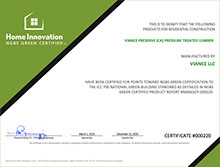
Preserve CA Green Certified Product Certificate

FREQUENTLY ASKED QUESTIONS
Superior colour to make your wood projects stand out.
1. What are the benefits of DesignWood?
- Colour and preservative protection in one step
- A finished project from the start - no need to initially stain
- Proven product performance with the longest lasting colourant on the market
- Works in unison with Preserve® CA environmentally advanced preservatives
- DesignWood with Preserve CA (Copper Azole), a fully dissolved, copper-based wood preservative, penetrates deeper into wood cells for more protection vs. other preservatives in the market.
- Preserve CA preservatives are made from 100% recycled copper.
- Preserve CA-B is CSA approved and has provided proven protection in Canada in severe environments since 2002.
- Preserve CA with DesignWood meets requirements of National Building Code of Canada (NBCC).
- Ideal for decks, fences, trellis’, docks and playsets
- Lifetime Limited Warranty against termites and fungal attack
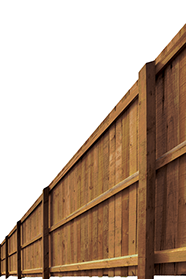
2. Can DesignWood be used for raised garden beds?
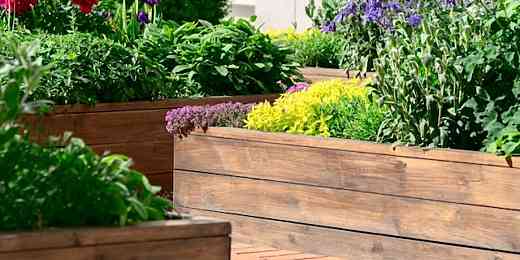 While there is scientific consensus that treated wood can be used for garden and vegetable beds, the information below explains what chemicals are used in Viance ground contact treated wood for residential use and the results of numerous scientific studies.
While there is scientific consensus that treated wood can be used for garden and vegetable beds, the information below explains what chemicals are used in Viance ground contact treated wood for residential use and the results of numerous scientific studies.The American Wood Protection Association (AWPA) specifies the use of treated lumber for horticultural purposes to be Ground Contact. In the AWPA Book of Standards, copper azole (CA) and alkaline copper quaternary (ACQ) are listed preservatives for Ground Contact use in residential applications. CA is widely available under the brand name Preserve® and is sold at 84 Lumber and independent lumber dealers across North America. ACQ has been replaced with CA-C and CA-B, prompted by the demand for quaternary needed in cleaning products due to the COVID-19 pandemic in 2020.
CA preservatives contain copper, the primary fungicide and termiticide in Viance’s ground contact product. The fungicide prevents soil fungus from attacking the lumber and works to deter insects, including termites. Copper is also a common fungicide for food crops used by consumers for growing vegetables and is a disinfectant in swimming pool chemicals.
Of interest to the home gardener is whether any of the preservative components in treated wood used to construct a raised bed garden could render the food crop unsafe for consumption. The available evidence suggests no.
New Research Study in Process – April 17, 2023, Update
Dr. Gerald Presley, Assistant Professor at Oregon State University, began a small-scale study in 2020 on metal leaching in treated wood garden boxes. After two growing seasons, eleven types of garden vegetables have been analyzed for copper content. These include arugula, basil, beets, carrots, kale, lettuce, parsnips, peas, radishes, tomatoes, and turnips. None of the vegetables grown in beds made with copper azole treated wood showed elevated copper levels compared to vegetables grown in beds constructed with untreated wood.
New Research Study in Process – February 24, 2022, Update
Dr. Gerald Presley, Assistant Professor at Oregon State University, began a small-scale study in 2020 on metal leaching in treated wood garden boxes. After one year, the data shows no difference in copper (Cu) content in vegetable matter harvested from treated or untreated boxes. Dr. Presley will plant each year, rotating crops, and monitor metals over a 4 to 5-year time period. The goal is to annually sample soil and crops to build a large, long-term dataset on many vegetables over the life of a garden box. Dr. Presley explains, “We still have a few more samples to process from year 1, but from what we see now there does not appear to be any measurable impact of treated wood garden boxes on metal levels in vegetables.” Annual data from this study will be presented at the American Wood Protection Association meeting and published in the proceedings. Data will also be available to members of the Environmental Performance of Treated Wood Research Cooperative in annual reports.
Prior Research
John Harrison, President of JRH Toxicology, a consulting firm specializing in scientific advice to the industry and government, writes in 2017 that CA and ACQ have been carefully evaluated for safety and registered by the Health Canada Pest Management Regulatory Agency (PMRA) for use in residential construction applications. He stated in a bulletin titled, Treated Wood in Raised Bed Gardening, “Scientific evidence and data have shown that using pressure treated wood for raised bed or box gardening is safe to adults and children in terms of the plants grown and used in these containers.” He further explains, “All chemicals in consumer products have a toxicity and most are very low, so they are not a problem, especially those regulated by the federal government. This is also the case with currently registered wood preservatives that contain copper. In fact, small amounts of copper are necessary for human and plant life and termed “an essential trace element”.
Dr. Scott Leavengood, Associate Professor College of Forestry at Oregon State University and Director of the Oregon Wood Innovation Center authored an article for the OSU Extension Service, titled “Raised bed lumber, pressure treated safe?” In this article, Leavengood gives his opinion that the consensus among researchers is that the low levels of chemicals in preservative treated wood that leach out of the wood into the soil are likely to be taken up by the plants only in very small amounts. There has been no evidence to suggest that the level of the chemicals is significant enough to be of concern for human health.
In a 2014 study, wood research scientists Love, Gardner and Morrell at Oregon State University found that in growing radishes, carrots and potatoes in a copper azole treated Douglas-fir planter, the copper levels were not higher in roots or tubers of radishes, carrots or potatoes compared to beds constructed from untreated wood. They also state that when people are concerned about the migration of wood preservatives, they can use polyethylene (plastic) to line the inside of the planter. Their scientific results indicate that although plastic lining is “not entirely necessary”, it can be used if there are safety concerns. The use of a plastic barrier will also extend the life of the preserved wood and help keep the raised bed garden soil within the bed area. For proper drainage, the plastic material should not be used underneath the raised bed garden.
Safe practices for working with treated wood recommend treated wood not be used where it may come into direct or indirect contact with drinking water or a component of food, animal feed or beehives. The USDA prohibits treated lumber for soil contact use in their certified National Organic Program published in 2011. The updated draft dated September 5, 2018 states that CA and ACQ are not currently allowed because they are not included on the National List of allowed synthetic materials (7 CFR part 205, page 425).
Viance recommends for those who have concerns to line the interior walls only with heavy plastic sheeting. There have been no justified claims that today’s treated lumber causes any negative effects from leaching into the soil.
Sources
Dr. Gerald Presley, Assistant Professor Oregon State University; https://www.researchgate.net/l...
https://scholar.google.com/cit...,
https://plantcaretoday.com/pressure-treated-lumber-for-a-vegetable-garden.html
https://www.finegardening.com/article/are-pressure-treated-woods-safe-in-garden-beds
https://extension.oregonstate.edu/raised-bed-lumber-pressure-treated-safe
https://extension.psu.edu/environmental-soil-issues-garden-use-of-treated-lumber
https://hgic.clemson.edu/factsheet/treated-wood-in-the-landscape/
https://www.woodpreservation.ca/.../Bulletin-Treated-Wood-In-Raised-Bed-Gardening...
https://www.ams.usda.gov/rules-regulations/organic/national-list
3. What screws and connectors do you recommend?
- Always use building code approved, corrosion-resistant fasteners and
connectors that are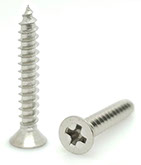 suitable for use in pressure treated wood.
suitable for use in pressure treated wood. - Recommended fasteners: Use hot-dipped galvanized fasteners
(meeting ASTM A 153) or stainless steel. - Recommended connectors: Use G185 hot-dipped galvanized for
exterior applications. - For permanent wood foundations and corrosive environments, such as coastal areas with saltwater spray, use code approved stainless steel fasteners and connectors.
- Wood treated with the DesignWood colorant and Preserve wood preservatives is not suitable for direct contact with uncoated steel or aluminum building products.
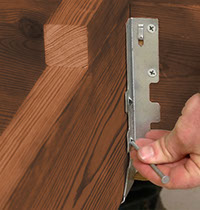
- Always use building code approved, corrosion-resistant fasteners and
4. What are the key installation tips?
- Freshly treated boards should be installed tightly together as they will shrink slightly in width and length as they dry out.
- Kiln dried after treatment (KDAT) boards should be properly spaced to allow water to pass between boards.
- Pre-drill holes no less than ½ inch (1.27 cm) at the ends of boards to help prevent splitting.
- Use screws to improve holding performance.
- Install fasteners flush to the wood surface. Do not overdrive fasteners.
- Place the best-looking side of a deck board face up lace the best-looking side of a deck board face up.
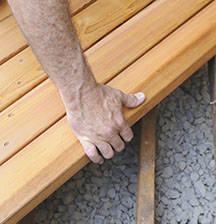
5. How do I remove the grade stamp on my boards?
- Light sanding will remove or lighten the grade stamp’s appearance.
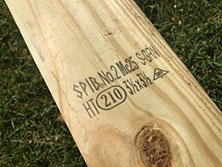
6. How long do I need to wait before I seal my deck or fence?
- Allow treated wood to dry prior to application - typically around 60 days after installation. Test the wood with a few drops of water to see if the wood is dry enough to readily absorb water, then test a small portion of the deck.
- Apply a water repellent sealer at least every two years to keep your project looking great.
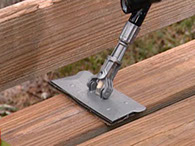
7. What is the best way to clean wood decks?
- Keep your outdoor living space looking its best with the right cleaners and sealers to
enhance its long-term beauty. - Liquid detergents, water and a stiff bristle brush will remove most mildew and dirt.
- Always follow the manufacturer’s mixing and application instructions.
- Never use household chloride bleaches on wood as it can cause damage to the wood
fibers and fasteners. - Care should be taken if a pressure-washer is used for cleaning, as excessive pressure
may cause damage to the wood.
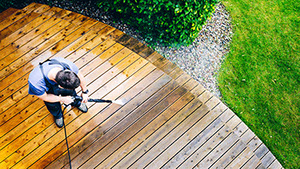
- Keep your outdoor living space looking its best with the right cleaners and sealers to
8. What are the safety practices for treated wood?
Is special handling required when working with treated wood?
Wear gloves when handling treated wood as wood may splinter, and always wear eye protection and a dust mask when cutting, sawing or sanding treated wood to reduce inhalation and prevent irritation to the nose, eyes and skin.
How should I dispose of unused treated wood?All treated wood scraps, debris and sawdust should be cleaned up and disposed of after construction in accordance with federal, state and local regulations.
Is it ok to burn treated wood?
When treated wood is burned, the chemical components of the preservative are concentrated and can be released into the ash and in particulates in the smoke. Some of these components can be harmful to the environment. Federal and state regulations mandate that treated wood be disposed of properly.
Why can I use pressure-treated wood outdoors for a picnic table but not for a countertop?Picnic tables are used primarily for serving pre-prepared food, while a kitchen countertop is used to prepare food and used as a cutting surface for raw food. Raw food can absorb the preservatives and be ingested.
What questions can we help with?

